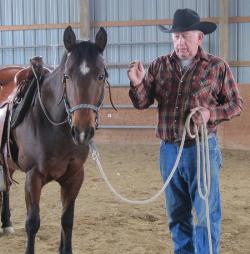With open minds and a few decades of experience, we can begin to see patterns, common developments across geographies, species, and time.
 It happened to me while listening to an interview with Peter Gould, a writer and producer for Breaking Bad, one of the most successful and critically-acclaimed TV series ever.
It happened to me while listening to an interview with Peter Gould, a writer and producer for Breaking Bad, one of the most successful and critically-acclaimed TV series ever.
He spoke about the process of writing episodes and how he considers and respects the audience.
“Let them be smart,” Gould said. “As Billy Wilder said, ‘Give them two and two. Let them make four. They’ll love you forever.
In other words, let the story be a collaboration, not a mandate.
Not a bad strategy for horsemanship, either.
Horsemen from Elijah Moore to Buck Brannaman stress the importance of letting horses find their way to the answer instead of forcing them to it.
Both horsemen share this example with a horse who’s practiced the one-rein stop:
Sitting on your horse, ask him to flex laterally by applying light pressure to one rein. If the two of you have done this before, your horse will bring his nose towards your stirrup. Now, instead of releasing your rein like he’s accustomed to, maintain pressure. Don’t offer release yet.
Let your horse think it through and solve the problem.
To get away from the pressure, your horse will eventually step over his hind quarters.
That’s when you release and reward.
That’s when you let him take two and two and make four.
Read how neuroscience impacts how the horse learns, with Martin Black and Dr. Steve Peters
